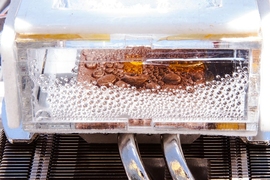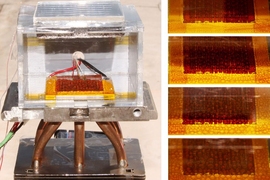With droughts plaguing much of the western United States and millions of people across the globe living without access to safe water, the need for technologies that produce clean water is greater than ever. The key, according to Evelyn Wang, the Gail E. Kendall Professor and department head for MIT’s Department of Mechanical Engineering, is in the very air we breathe.
“Water vapor is all around us in the air, even in arid conditions,” explains Wang. She and her team in MIT’s Device Research Laboratory have developed a device that can tap into this abundant resource and literally pull water out of thin air. This project is currently being supported by a seed grant from MIT's Abdul Latif Jameel World Water and Food Security Lab (J-WAFS), and involves a collaboration with co-PI Mircea Dinca, associate professor in the Department of Chemistry.
The key to the process is a powder that desiccates the air, attracting vapor directly to the porous matrix at the base of the device’s main chamber like a sponge. The vapor is then condensed into liquid and can be collected as usable water – even in dry atmospheres with as low as 20 percent humidity.
The entire process of converting the water vapor found in air into potable water can be done using only the power of the sun. “The device is completely passive,” says Wang. “There is no need to use outside power supplies which can help keep the device low-cost and efficient.”
Keeping costs low and efficiency high is one of Wang’s central goals. “We hope to develop a device that provides relief to the millions of people living in communities that lack the infrastructure needed to provide access to clean drinking water or those living in regions plagued by drought,” adds Wang.
During a field test in Tempe, Arizona earlier this year, a small proof-of-concept prototype of the device extracted a quarter-liter of water per day per kilogram of the absorbent powder. The researchers hope to increase this output by further tailoring the powder and optimizing the device.
If the production capacity of the device can be increased, Wang’s research could have a tangible impact in places experiencing water scarcity — even in the driest of conditions.
Submitted by: Mary Beth O'Leary / Department of Mechanical Engineering | Video by: John Freidah | 1 min, 23 sec








